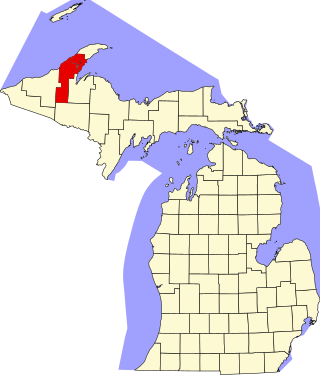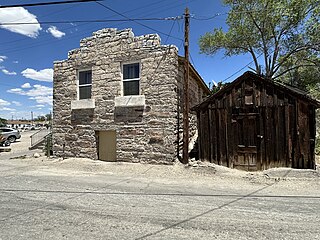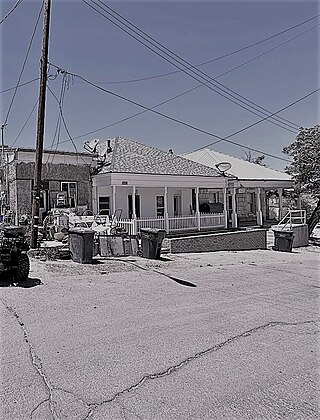
Tonopah is an unincorporated town in and the county seat of Nye County, Nevada, United States. Nicknamed the Queen of the Silver Camps for its mining-rich history, it is now primarily a tourism-based resort city, notable for attractions like the Mizpah Hotel and the Clown Motel.

Goldfield is an unincorporated town and census-designated place and the county seat of Esmeralda County, Nevada.

This is a list of the National Register of Historic Places listings in Houghton County, Michigan.

The Brokers Exchange in Tonopah, Nevada, also known as the Tonopah Divide Mining Company was built in 1905 during Tonopah's mining boom. Originally a two-story building, it housed a brokerage, real estate office, and the offices of Tonopah lawyer Patrick McCarran. A fire destroyed the upper floor in 1912. The Tonopah Divide Mining Company, controlled by George Wingfield and Cal Brougher, purchased the property for use as an office in 1919. The ruined top story was removed and the first floor was re-roofed and capped with a decorate plaster frieze.

The Water Company of Tonopah Building is a historic building located at the intersection of Burrough and Brougher Avenues in Tonopah, Nevada. Built in 1909, the building housed offices for the Water Company of Tonopah. Tonopah's first water service began in 1902, when three water companies each gained franchises to provide water to one district of the town. By 1905, Philadelphia businessman John Brock owned two of the water companies, which he consolidated into the Water Company of Tonopah. Brock also owned multiple mines in Tonopah and the local railroad. The Water Company of Tonopah Building is the only surviving building which belonged to one of Tonopah's early water companies.

The Tonopah Mining Company Cottage is a historic house located on Queen Street in Tonopah, Nevada. Built in 1902, the home is one of the oldest frame houses in Tonopah. The house was constructed by the Tonopah Mining Company, the largest silver mining company in Tonopah. The cottage was the second home built for the company's employees and the oldest of the three surviving company houses built by the company.

The Tonopah Mining Company House is a historic house located on Queen Street in Tonopah, Nevada. The house was built in 1904 by the Tonopah Mining Company and served as a company house for its employees. The wood-frame house was designed in the Georgian Revival style. The house's design features an entrance porch topped by a gable, three chimneys, boxed eaves, and molded cornices.

The Tonapah Extension Mining Company Power Building is a historic power plant located on Main Street in Tonopah, Nevada. The building was constructed by 1920 by the Tonopah Extension Mining Company, possibly as a replacement for a 1909 plant. The plant was built with fired brick, an unusual construction material in the area. It is the only surviving building from the Tonopah Extension Mine, a major Tonopah mine which opened in 1903.

The Wieland Brewery Building is a historic building located on Mineral Street in Tonopah, Nevada. Built in 1901, the building was the first stone building constructed in Tonopah. It was also one of the first permanent buildings built in the town, which was still primarily a mining camp at the time. The building had several owners in its early years. It was apparently first owned by H.C. Brougher, but businessman Harry King bought the brewery by the end of 1901. King sold the brewery to two other businessmen in the spring 1902 but purchased it again by the following October. At the end of 1902, King added a crafted parapet to the building, which indicates that Tonopah had local stone craftsmen by that time.

The Cal Shaw Adobe Duplex is an adobe house located at 129 Central Street in Tonopah, Nevada. The house, which was built in 1905, is typical of the adobe homes commonly built in Tonopah in the early 1900s. The building's exterior is scored to resemble stone; the home's design also features a decorative frieze and a porch supported by turned columns. The home has changed little since its construction and has been called "the best preserved adobe residence in Tonopah" by a local historic survey.

The Cal Shaw Stone Row House is a stone row house located on Central Street in Tonopah, Nevada, United States. Property owner Cal Shaw built the house in 1906 next to the Cal Shaw Adobe Duplex, which was built the previous year. While the house was built with stone instead of adobe, it features a similar design to the adobe house, particularly in its projecting roof and porch supported by columns. The house and its neighbor reflect the variety of homes built on Central Street, one of the earliest residential areas in Tonopah. In addition, the house's detailed and well-preserved design led a local historic survey to call it "one of the best preserved examples of stone residential construction in Tonopah".
The Combellack Adobe Row House is an adobe row house located on Central Street in Tonopah, Nevada. The Tonopah Extension Mining Company built the home in 1903 to house its employees. The house is the oldest adobe home in Tonopah; its walls were cast in place rather than built in blocks, as the former method was more efficient and more popular in the town. The home was part of one of Tonopah's first residential areas on Central Street, which was a well-developed district by 1904. J.M. Combellack, who had lived in the home since it was built, became its owner in 1905.

The Charles Clinton Stone Row House is a stone row house located at 151 Central Street in Tonopah, Nevada, United States. Charles Clinton built the house in 1905 to use as a boarding house. The building's plan, designed to fit a narrow plot of land, features a series of rooms connected by an inside corridor. The house was built in ashlar stone and is topped by a hipped roof. After its use as a boarding house, the building served as a hospital.

The Judge W. A. Sawle House is a historic house located at 151 Central Street in Tonopah, Nevada, United States. W. A. Sawle, the local Justice of the Peace, built the house for himself in 1904. The frame house was designed in a blend of the Late Victorian and Colonial Revival styles. The home has a T-shaped plan and features a verandah with a crooked shape and a balustrade, wooden jig-cut bracketing along the top of the verandah, and a hipped roof. While living in the house, Sawle became Nye County's recorder and auditor, helped establish Tonopah's first Justice Court building, fathered the first baby born in the city, and invested in the local mining business.

The Stone Jail Building and Row House are two adjacent stone buildings located on Water Street in Tonopah, Nevada. The jail was built in 1903 and the adjacent row house in 1908. Both building were at one time used as a brothel. The buildings were added to the National Register of Historic Places in 1982.

The Zeb Kendall House, at 159 University Ave. in Tonopah, Nevada, United States, was built in 1906. It was listed on the National Register of Historic Places in 1982.

The Dr. J. R. Masterson House, at Ohio Ave. and 2nd St. in Tonopah, Nevada, is a 35-by-35-foot stone and frame historic building that was built in 1908. It has also been known as the Fred Chapman House. It was built as a residence and later served as a rooming house for most of its existence. It was a work of James Golden. It was listed on the National Register of Historic Places in 1982.

The E. E. Burdick House, at 248 Prospect St. in Tonopah, Nevada, United States, was built in 1906. It has also been known as St. Marks P.E. Church Parsonage. It was listed on the National Register of Historic Places in 1982.

The Uri B. Curtis House, at 169 Booker St. in Tonopah, Nevada, United States, was built in 1906. It was listed on the National Register of Historic Places in 1982.
John Wellington Finch was an American mining engineer and the 6th director of the U.S. Bureau of Mines.




















